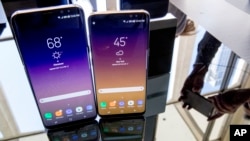One of the newest “smart” devices is an old favorite, a camera. And smart cameras are getting smarter all the time.
Some are now built with machine learning tools to help them think for themselves. Machine learning involves putting large amounts of data into a computer for processing.
The computer uses an algorithm to process the data and learn from it. The machine then trains itself over time to make predictions and decisions about future actions.
This technology helps cameras operate on their own by reacting to people and objects in a particular environment.
Google Clips
One of the latest to launch is Google Clips. It is the first camera developed by the web search giant that is not built into a phone.
Google Clips is very small, weighing just 60 grams. The device is designed to be put somewhere in a room to take pictures by itself. It can also be attached to an object or a person’s clothing.
Google says machine learning helps the camera choose the best times and situations for taking pictures and video clips. It can also recognize the faces of people or pets chosen by the user and take pictures of them in a more natural way.
“Google Clips is smart enough to recognize great expressions, lighting and framing,” the company says on its website.
Google says privacy controls have been built into the camera to give users complete control over which images they send to other devices or share with others.
The price for Google Clips is $249. The device is not yet being sold, but interested buyers can join a waiting list to be informed when it is available.
GoPro Hero
GoPro is another company developing machine learning technology. The company’s Hero5 and Hero6 models are designed to be easily taken anywhere and can automatically capture photos and video. The Hero5 Session camera can be controlled by voice to allow for total hands-free usage.
GoPro also uses machine learning to power its QuikStories feature. This tool takes existing photos and videos and automatically creates a finished video piece, complete with music and effects.
Snap Spectacles
Messaging app Snapchat sells a pair of sunglasses with a built-in camera that can record short video clips with the push of a button. Snap Inc. says the product, called Spectacles, is designed to “capture the moment, without taking you out of it.”
While GoPro’s cameras and Snapchat’s Spectacles are designed to be used mostly outdoors, Google says Clips “works best when used at home with family and close friends.”
Both GoPro and Snap Inc. plan to keep developing machine learning technology. But so far, neither has released products with smart-capture capabilities comparable to Google Clips.
Many smartphones already have facial recognition technology built into the devices.
Apple iPhone X
Apple’s new iPhone X is being launched with its new Face ID system that it says will unlock the phone just by having the user look at it. This replaces the Touch ID on previous devices that used a fingerprint to unlock the phone.
Apple says the system works by projecting more than 30,000 dots on the face to create a kind of map. An infrared camera then reads the dots to create an image that can be confirmed as a match. Apple claims its facial recognition is even secure enough to allow payments through its Apple Pay service.
Samsung S8
Samsung’s S8 smartphones also use eye and facial recognition technology to unlock devices.
Earlier this year, Samsung also launched its new voice assistant Bixby. The service uses machine learning to automatically search and bring up information on things that are photographed. The technology also allows voice to control many device actions.
I’m Bryan Lynn.
Bryan Lynn wrote this story for VOA Learning English. Hai Do was the editor.
We want to hear from you. Write to us in the Comments section, and visit our Facebook page.
_____________________________________________________________
Words in This Story
algorithm – n. set of steps that are followed in order to solve a mathematical problem or to complete a computer process
framing – n. basic structure holding other things inside
automatically – adv. allowing something to work or happen without being directly controlled by a person
app – n. a computer program that performs an activity
project – v. to cause something to appear on a surface














